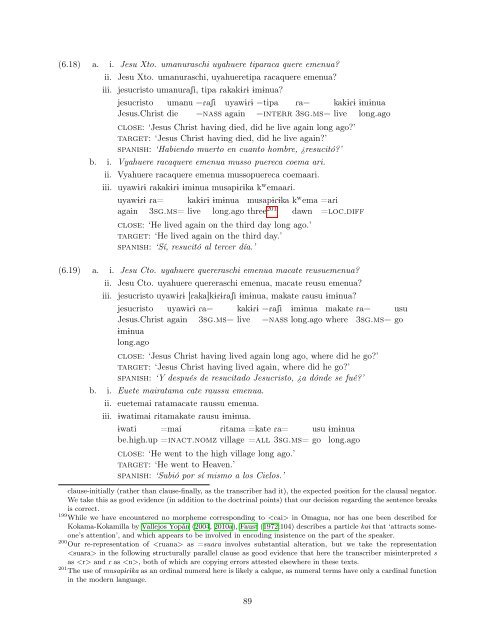draft manuscript - Linguistics - University of California, Berkeley
draft manuscript - Linguistics - University of California, Berkeley
draft manuscript - Linguistics - University of California, Berkeley
Create successful ePaper yourself
Turn your PDF publications into a flip-book with our unique Google optimized e-Paper software.
(6.18) a. i. Jesu Xto. umanuraschi uyahuere tiparaca quere emenua?<br />
ii. Jesu Xto. umanuraschi, uyahueretipa racaquere emenua?<br />
iii. jesucristo umanuRaSi, tipa Rakak1R1 1m1nua?<br />
jesucristo umanu =RaSi uyaw1R1 =tipa Ra= kak1R1 1m1nua<br />
Jesus.Christ die =nass again =interr 3sg.ms= live long.ago<br />
close: ‘Jesus Christ having died, did he live again long ago?’<br />
target: ‘Jesus Christ having died, did he live again?’<br />
spanish: ‘Habiendo muerto en cuanto hombre, ¿resucitó?’<br />
b. i. Vyahuere racaquere emenua musso puereca coema ari.<br />
ii. Vyahuere racaquere emenua mussopuereca coemaari.<br />
iii. uyaw1R1 Rakak1R1 1m1nua musap1R1ka k w emaaRi.<br />
uyaw1R1<br />
again<br />
Ra= kak1R1 1m1nua musap1R1ka k w ema =aRi<br />
3sg.ms= live long.ago three 201 dawn =loc.diff<br />
close: ‘He lived again on the third day long ago.’<br />
target: ‘He lived again on the third day.’<br />
spanish: ‘Sí, resucitó al tercer día.’<br />
(6.19) a. i. Jesu Cto. uyahuere quereraschi emenua macate reusuemenua?<br />
ii. Jesu Cto. uyahuere quereraschi emenua, macate reusu emenua?<br />
iii. jesucristo uyaw1R1 [Raka]k1R1RaSi 1m1nua, makate Rausu 1m1nua?<br />
jesucristo<br />
Jesus.Christ<br />
1m1nua<br />
long.ago<br />
uyaw1R1<br />
again<br />
Ra= kak1R1 =RaSi 1m1nua makate Ra= usu<br />
3sg.ms= live =nass long.ago where 3sg.ms= go<br />
close: ‘Jesus Christ having lived again long ago, where did he go?’<br />
target: ‘Jesus Christ having lived again, where did he go?’<br />
spanish: ‘Y después de resucitado Jesucristo, ¿a dónde se fué?’<br />
b. i. Euete mairatama cate raussu emenua.<br />
ii. euetemai ratamacate raussu emenua.<br />
iii. 1watimai Ritamakate Rausu 1m1nua.<br />
1wati =mai Ritama =kate Ra= usu 1m1nua<br />
be.high.up =inact.nomz village =all 3sg.ms= go long.ago<br />
close: ‘He went to the high village long ago.’<br />
target: ‘He went to Heaven.’<br />
spanish: ‘Subió por sí mismo a los Cielos.’<br />
clause-initially (rather than clause-finally, as the transcriber had it), the expected position for the clausal negator.<br />
We take this as good evidence (in addition to the doctrinal points) that our decision regarding the sentence breaks<br />
is correct.<br />
199 While we have encountered no morpheme corresponding to in Omagua, nor has one been described for<br />
Kokama-Kokamilla by Vallejos Yopán (2004, 2010a), Faust (1972:104) describes a particle kai that ‘attracts someone’s<br />
attention’, and which appears to be involved in encoding insistence on the part <strong>of</strong> the speaker.<br />
200 Our re-representation <strong>of</strong> as =suaRa involves substantial alteration, but we take the representation<br />
in the following structurally parallel clause as good evidence that here the transcriber misinterpreted s<br />
as and R as , both <strong>of</strong> which are copying errors attested elsewhere in these texts.<br />
201 The use <strong>of</strong> musap1R1ka as an ordinal numeral here is likely a calque, as numeral terms have only a cardinal function<br />
in the modern language.<br />
89
















